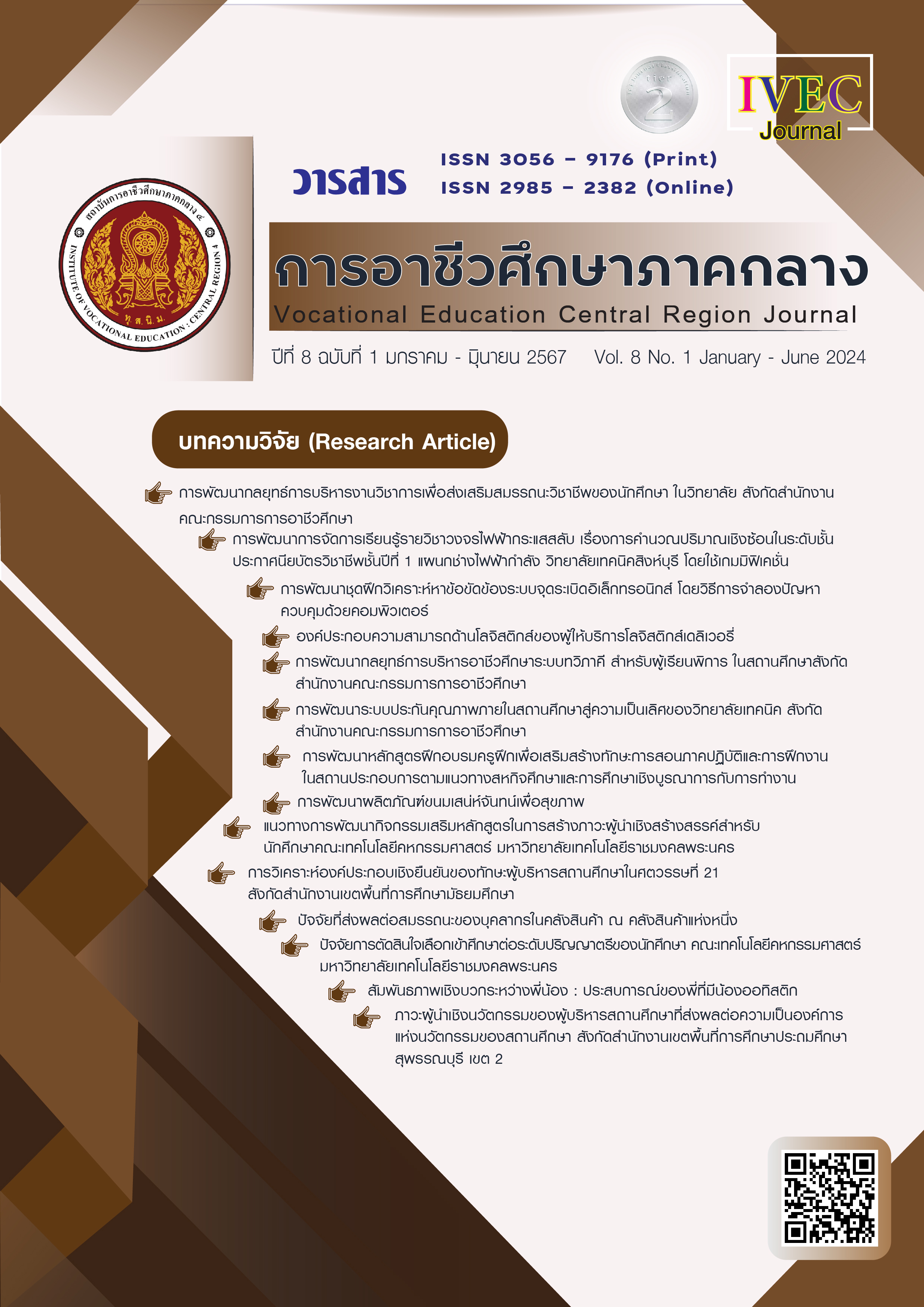Confirmatory Component Analysis of the School Administrators Skills in the 21st Century under the Secondary Educational Service Area Office
Main Article Content
Abstract
The objectives of this research article are 1) to analyze the components and indicators of the skills of school administrators in the 21st century under the Secondary Educational Service Area Office and 2) to analyze the confirmatory components of the skills of school administrators in the 21st century. Under the jurisdiction of the Secondary Educational Service Area Office. It is survey research. A sample group of 350 people was selected using a multi-stage sampling method. The instrument used was a questionnaire measuring a 5 – level rating scale. Statistics for data analysis included mean, standard deviation. and confirmatory factor analysis (CFA)
The results of the research found that a confirmatory factor analysis of the skills of school administrators in the 21st century under the Secondary Educational Service Area Office found that 5 components and 25 indicators had construct validity. It is consistent with empirical data. Considering that the statistics meet the criteria for every index (x2 = 332.24, df = 246, p-value = 0.00020, x2/df = 1.35, GFI = 0.93, AGFI = 0.91, RMSEA = 0.032), which the weight of the components ranks; The 1st place has a value between 0.29 and 0.96 and the 2nd place weight has a value between 0.79 and 0.96 The component with the most important weight is Results Orientation skills, followed by Judgment skills, Setting Instructional Direction skills, Organizational Ability skills, and Teamwork skills.
Article Details

This work is licensed under a Creative Commons Attribution-NonCommercial-NoDerivatives 4.0 International License.
|
บทความ ข้อมูล เนื้อหา รูปภาพ ฯลฯ ที่ได้รับการตีพิมพ์ในวารสาร การอาชีวศึกษาภาคกลาง ถือเป็นลิขสิทธิ์ของวารสารการอาชีวศึกษาภาคกลางหากบุคคลหรือหน่วยงานใดต้องการนำทั้งหมดหรือส่วนใดส่วนหนึ่ง ไปเผยแพร่ต่อหรือเพื่อกระทำการใด ๆ กองบรรณาธิการไม่สงวนสิทธิ์ ในการคัดลอกบทความเพื่อการศึกษาแต่ให้อ้างอิงแหล่งที่มาให้ครบถ้วน สมบูรณ์ สงวนสิทธิ์ โดย สถาบันการอาชีวศึกษาภาคกลาง 4 ที่ตั้ง 90 ถนนเทศา ตำบลพระปฐมเจดีย์ อำเภอเมือง จังหวัดนครปฐม โทรศัพท์ 034 242 856 , โทรสาร 034 242 858 ISSN : 3056-9176 (print) ISSN : 2985-2382 (online) |
References
จริญญาภรณ์ ศรีจันดารี และ จุฬาพรรณภรณ์ ธนะแพทย์. (2564, กันยายน-ธันวาคม). บทบาทของผู้บริหารสถานศึกษาในศตวรรษที่ 21. มจรอุบลปริทรรศน์, 6, (3), หน้า 865-876.
จักรกฤษณ์ เกษไธสง, มิตภาณี พุ่มกล่อม, และ พงษ์ศักดิ์ รวมชมรัตน์. (2565, มกราคม-เมษายน). ทักษะผู้นำในศตวรรษที่ 21 สังกัดสำนักงานเขตพื้นที่การศึกษาประถมศึกษาภาญจนบุรี เขต 4. นวัตกรรมการศึกษาและการวิจัย, 6, (1), หน้า 1-15.
ชัยยนต์ เพาพาน. (2559, มกราคม-มิถุนายน). แนวคิดและทฤษฎีพื้นฐานการเป็นผู้นำของผู้บริหารสถานศึกษาในศตวรรษที่ 21. บริหารการศึกษามหาวิทยาลัยขอนแก่น, 12, (1), หน้า 1-9.
พระศราวุฒิ มหาลาโภ (หงษ์คำ) และ ธรรมรัตน์ โพธิ สุวรรณปัญญา. (2562, พฤษภาคม-สิงหาคม). ทักษะการบริหารแบบมืออาชีพของผู้บริหารองค์กรยุคไทยแลนด์ 4.0. สถาบันวิจัยและพัฒนามหาวิทยาลัยราชภัฏชัยภูมิ, 1, (2), หน้า 1-14.
พรทิพย์ มงคลเสถียร, พิมผกา ธรรมสิทธิ์, และ ชัชภูมิ สีชมภู. (2563, มกราคม-มิถุนายน). การพัฒนาตัวบ่งชี้ทักษะการบริหารในศตวรรษที่ 21 ของผู้บริหารสถานศึกษาขั้นพื้นฐาน สังกัดสำนักงานเขตพื้นที่การศึกษาประถมศึกษาพิษณุโลก เขต 3. บัณฑิตวิจัย, 11, (1), หน้า 121-134.
ศศิรดา แพงไทย. (2559, มกราคม–มิถุนายน). บทบาทของผู้บริหารสถานศึกษาในศตวรรษที่ 21. วิทยาลัยบัณฑิตเอเชีย, 6, (1), หน้า 7-11.
ศรสวรรค์ บุญณกรณ์ชัย. (2561). ภาวะผู้นำของผู้บริหารสถานศึกษาในศตวรรษที่ 21 โรงเรียนทวีธาภิเศก สังกัดสำนักงานเขตพื้นที่การศึกษามัธยมศึกษา เขต 1. การศึกษาค้นคว้าอิสระ ปริญญาศึกษาศาสตร์มหาบัณฑิต สาขาวิชาการบริหารการศึกษา บัณฑิตวิทยาลัย มหาวิทยาลัยเกริก.
สำนักงานเลขานุการของคณะกรรมการยุทธศาสตร์ชาติ. (2561). ยุทธศาสตร์ชาติ พ.ศ. 2561-2580 (ฉบับประกาศราชกิจจานุเบกษา). กรุงเทพฯ: สำนักงานคณะกรรมการพัฒนาเศรษฐกิจและสังคมแห่งชาติ.
Comrey, A. L., & Lee, H. B. (1992). A First Course in Factor Analysis. (2nd ed.). Hillsdale,New Jersey: Lawrence Erlbaum Associated.
Hair, J., Black, W., Babin, B., Anderson, R., & Tatham, R. (2006). Multivariate Data Analysis. (6th ed.). New Jersey: Prentice Hall.


